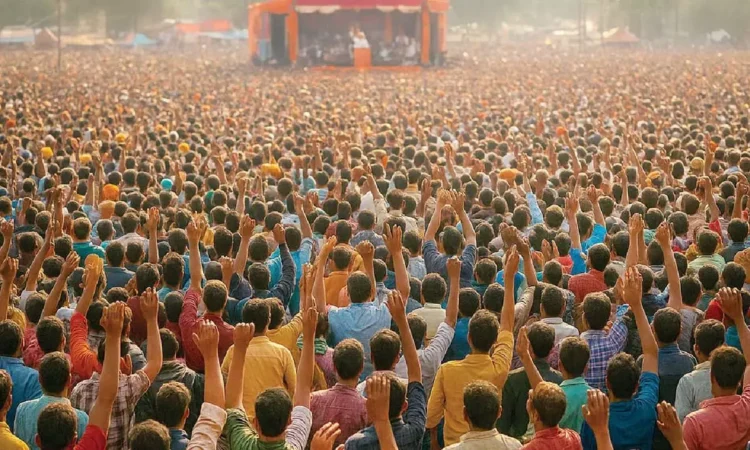India, home to 1.4 billion people, is a resilient democracy that has weathered numerous challenges. As the world’s fourth-largest economy by nominal GDP, it boasts the largest GenZ population and a rich tapestry of ethnicities, cultures, languages, and festivals. With the increasing scale of public gatherings, effective crowd management has emerged as a critical human challenge for governance. A crowd is an unorganized assembly of individuals lacking a common objective or identity, leading to irrational and fleeting behaviors, while a group is characterized by shared identity and purpose, fostering deeper connections. Both can evolve into a mob, marked by heightened emotional intensity and diminished individual identity and moral restraint (Deindividuation).
The nature of crowds is dynamic and unpredictable, embodying the collective energy of individuals who temporarily relinquish personal restraint in favor of shared emotions or goals. Thus, crowd management transcends mere physical control; it is fundamentally about understanding human behavior in mass contexts. In India, with its rapidly growing population, managing human movement in confined or emotionally charged environments has become increasingly complex. The global market for crowd management systems, valued at $2.5 billion in 2024, is expected to expand to $5.1 billion by 2033. The demographic boom has placed tremendous strain on public infrastructure, evidenced by overcrowded railway platforms, congested urban intersections, and massive gatherings during religious events like the Kumbh Mela.
Such scenarios illustrate how high population density amplifies both the opportunities and vulnerabilities inherent in collective life. A larger populace not only means more individuals but also greater emotional diversity and unpredictability among crowds. As cities grow and migration increases, effective crowd management now necessitates a blend of psychology, technology, and meticulous planning. Understanding group psychology is crucial to addressing this challenge. Theories of group dynamics, from Kurt Lewin to Gustave Le Bon, highlight that individuals often behave differently within a crowd. Personal judgment may yield to collective emotions, with anonymity and shared purpose potentially leading to reactions ranging from unity to aggression.
The behavior of crowds is explained through various theories, including Contagion theory (where emotions spread rapidly, causing irrationality), Convergence theory (where crowds form from individuals with similar beliefs), and Emergent-Norm theory (where norms develop within the crowd). Crowds can devolve into mobs when factors such as anonymity, lack of social control, and environmental triggers (like cramped spaces) converge, resulting in a loss of individual accountability and an increase in suggestibility and often violent behaviors. Crowd management in India has gained urgency following incidents like the stampede at a political rally in Karur, Tamil Nadu, which drew over 30,000 attendees.
According to the NCRB report on Accidental Deaths and Suicides in India, from 2000 to 2022, there were 3,074 fatalities due to stampedes, with nearly 4,000 incidents recorded over the last three decades. A staggering 79 percent of these stampedes occurred between 2001 and 2014 at places of worship. From Kumbh Mela to political gatherings, comprehending human behavior is essential to avert tragedies. Safe and organized gatherings are rooted not only in physical barriers but also in empathy, respect, and civic responsibility. Effective crowd management intertwines human behavior with logistics and infrastructure. While millions may be in motion, the outcome can be either safe or chaotic, hinging on adequate planning and awareness.
Tragic stampedes often stem from minor lapses in communication or crowd flow. The 2025 Kumbh Mela serves as a case study for effective management. This event, one of the largest human gatherings globally, showcased the scale and sophistication of crowd control. An estimated 670 million attendees participated, peaking at 76 million on January 29, 2025. The Indian Railways undertook extensive planning, including the establishment of temporary terminals and satellite stations to facilitate train operations. AI-driven crowd density tools and drone surveillance operated continuously. Coordination among railways, police, and civil authorities was real-time, and front-line staff received behavioral training to maintain order and communicate effectively. Technology, combined with empathy, AI, and analytics, supported these efforts.
Infrastructure readiness included periodic redesigns and mock drills, resulting in a record 17,152 trains being operated, along with significant improvements to infrastructure and passenger amenities. Major upgrades to Prayagraj and nearby stations included the addition of 48 new platforms and various bridges. Permanent holding areas were constructed to manage crowds during peak times, and 1,186 CCTV cameras with live feeds enhanced control room monitoring. Multilingual announcements facilitated communication. Traffic management involved nine stations and unidirectional movement of passengers to prevent stampedes. This model of crowd management is now being replicated across the Indian Railways system.
As India prepares for upcoming events like the Singasth Kumbh in Nasik (2027), Pushkaram in Rajahmundry (2027), and Kumbh in Ujjain (2028), significant redevelopment efforts are underway at these stations. The success of Indian Railways at Prayagraj provides a roadmap for the country to implement safe crowd management practices. Simulation models, clear signage, crowd movement mapping, and emergency communication systems, along with substantial infrastructure improvements, are essential for effective crowd management. In conclusion, crowds will continue to grow, and gatherings will persist. However, if managed intelligently and with empathy, they can embody what they are meant to be—a manifestation of collective purpose rather than collective panic.
The enduring lesson from Kumbh and every crowded platform in India is that to effectively move the masses, one must first comprehend the mindset. Indian Railways has initiated plans for managing crowd control during peak festival seasons and summer surges by creating holding areas for passenger convenience. A notable advancement at one of the busiest terminals, the newly constructed Yatri Suvidha Kendra (Permanent Holding Area) at New Delhi Railway Station, can accommodate around 7,000 passengers at a time, significantly enhancing pre-boarding comfort and flow. Similar centres will also be developed at other stations nationwide.
